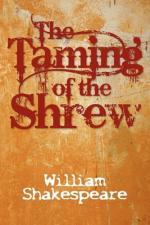|
This section contains 6,343 words (approx. 22 pages at 300 words per page) |

|
SOURCE: “Renaissance Family Politics and Shakespeare's The Taming of the Shrew,” in English Literary Renaissance, Vol. 16, No. 1, Winter, 1986, pp. 86-100.
In the following essay, Newman analyzes gender and power roles in The Taming of the Shrew against the backdrop of Elizabethan culture.
Wetherden, Suffolk. Plough Monday, 1604. A drunken tanner, Nicholas Rosyer, staggers home from the alehouse. On arriving at his door, he is greeted by his wife with “dronken dogg, pisspott and other unseemly names.” When Rosyer tried to come to bed to her, she “still raged against him and badd him out dronken dogg dronken pisspott.” She struck him several times, clawed his face and arms, spit at him and beat him out of bed. Rosyer retreated, returned to the alehouse, and drank until he could hardly stand up. Shortly thereafter, Thomas Quarry and others met and “agreed amongest themselfs that the said Thomas Quarry who dwelt...
|
This section contains 6,343 words (approx. 22 pages at 300 words per page) |

|


